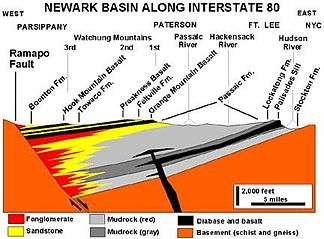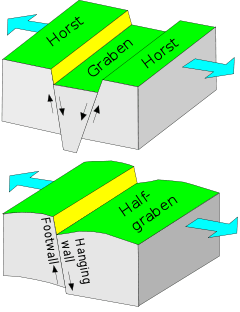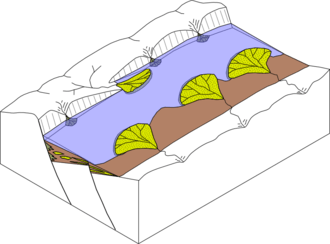Half-graben
A half-graben is a geological structure bounded by a fault along one side of its boundaries, unlike a full graben where a depressed block of land is bordered by parallel faults.

Rift and fault structure


A rift is a region where the lithosphere extends as two parts of the Earth's crust pull apart. Often a rift will form in an area of the crust that is already weakened by earlier geological activity.[1] Extensional faults form parallel to the axis of the rift.[2] An extensional fault may be seen as a crack in the crust that extends down at an angle to the vertical. As the two sides pull apart, the hanging wall ("hanging over" the sloping fault) will move downward relative to the footwall.[3] The crust thins and sinks, forming a rift basin. Warm mantle material wells up, melting the crust and often causing volcanoes to emerge in the rift basin.[1]
Extensional basins may appear to be caused by a graben, or depressed block of land, sinking between parallel normal faults that dip towards the center of the graben from both sides. In fact, they are usually made of linked asymmetrical half-grabens. Faults with antithetic slope directions linked in to a controlling fault, or periodic changes of dip in the controlling faults, give the impression of full graben symmetry.[2]
As the rift expands, the rift flanks lift up due to isostatic compensation of the lithosphere. This creates the asymmetric topographic profile that is typical of half grabens. The half grabens may have alternating polarities along the rift axis, dividing the rift valley into segments.[4]
Intracontinental and marine rift basins such as the Gulf of Suez, East African Rift, Rio Grande rift system and the North Sea often contain a series of half-graben sub-basins, with the polarity of the dominant fault system changing along the axis of the rift. Often the extensional fault systems are segmented in these rifts. Rift border faults with lengths over 10 kilometres (6.2 mi) are separated by relay ramp structures. The relay ramps may provide pathways for sediment to be carried into the basin. Typically the rift is broken along its axis into segments about 50 to 150 kilometres (31 to 93 mi) long. [5]
Sedimentation

Four zones of sedimentation can be defined in a half-graben. The first is "escarpment margin" sedimentation, found along the major border faults bounding the half graben, where the deepest part of the basin meets the highest rift-shoulder mountains.[6] Comparatively little sediment enters the half-graben across the major bounding fault, since uplift of the footwall causes the land on the footwall side to slope away from the fault. Rivers on that side therefore carry sediment away from the rift valley.[7] But as the lowest part of the basin with the greatest rate of subsidence, the escarpment margin experiences the highest rates of sedimentation, which may accumulate to several kilometers in depth.[8] This sedimentation often includes very coarse debris such as huge blocks from rock falls, as well as fans of sediment from the basin wall. Other material is transported across or along the basin to the deep water parts of a rift lake along the escarpment margin.[6]
Most of the sediment will enter the half-graben down the unfaulted hanging wall side.[7] On the side of the basin opposite the main border fault, sedimentation occurs along the "hinged margin", which may also be called the "shoaling margin" or the "flexural margin". In this part of the basin, slopes are usually gentle and large river systems may carry sediment into the basin, which may be stored in deltas where they enter a rift valley lake. Littoral and sub-littoral carbonate deposits may well be accumulated in these conditions. The "axial margins" at the ends of basins often include low-gradient ramps where major rivers enter the basin, building deltas and creating currents within a rift lake that can carry sediment from one end to the other. Between adjacent half grabens there will be "accommodation zones" that may include local extension, compression or strike-slip faulting. These can create complex morphologies within which different mechanisms affect sedimentation. The types of sedimentation in half grabens also depends on lake levels in the rift, the climate (e.g. tropical versus temperate) in which the sediments form and the water chemistry.[6]
Lake Baikal is an unusually large and deep example of half-graben evolution. The lake is 630 by 80 kilometres (391 by 50 mi), with a maximum depth of 1,700 metres (5,600 ft). Sediment in the depression may be up to 6,000 metres (20,000 ft) in depth. The system also includes some small Quaternary volcanoes.[9] In this lake, at first a series of half-grabens were linked in a linear chain. As the rift valley aged, extensive deformation developed on both sides of the lake, converting them into asymmetric full grabens.[8]

Examples of half-grabens
| Graben | Fault | Age | Location |
|---|---|---|---|
| Albuquerque Basin | middle Miocene and early Pliocene | United States | |
| Cheshire Basin | Red Rock Fault | Late Palaeozoic and Mesozoic | England |
| Ellisras Basin | Melinda Fault Zone | Permian | South Africa |
| Erris Trough | Erris Ridge | Permian to Triassic and middle Jurassic | Ireland |
| Lake Baikal | Cenozoic | Russia | |
| Newark Basin | Early Mesozoic | United States | |
| Pannonian Basin | Hungary | ||
| Saint Lawrence rift system | Canada | ||
| Slyne Trough | Triassic and Middle Jurassic | Ireland | |
| Taipei Basin | Taiwan | ||
| Vale of Clwyd | Vale of Clwyd Fault | Permian and Triassic | Wales |
| Widmerpool Gulf | Hoton Fault | Early Carboniferous | England |
References
Citations
- van Wijk 2005.
- Holdsworth & Turner 2002, p. 225.
- Holdsworth & Turner 2002, p. 249.
- Kearey, Klepeis & Vine 2009, p. 155.
- Davies 2004, p. 101.
- Cohen 2003, p. 210.
- Nelson et al. 1999.
- Cohen 2003, p. 208.
- Ollier 2000, p. 60.
- Russell & Snelson 1994, pp. 83-112.
Sources
- Cohen, Andrew S. (2003-05-29). Paleolimnology: The History and Evolution of Lake Systems. Oxford University Press. ISBN 978-0-19-513353-0. Retrieved 2012-09-27.CS1 maint: ref=harv (link)
- Davies, Richard J. (2004). 3D Seismic Technology: Application to the Exploration of Sedimentary Basins. Geological Society. ISBN 978-1-86239-151-2. Retrieved 2012-09-27.CS1 maint: ref=harv (link)
- Holdsworth, Robert E.; Turner, Johnathan P. (2002). Extensional Tectonics: Regional-scale processes. Geological Society of London. ISBN 978-1-86239-114-7. Retrieved 2012-09-27.CS1 maint: ref=harv (link)
- Kearey, Philip; Klepeis, Keith A.; Vine, Frederick J. (2009-01-27). Global Tectonics. John Wiley & Sons. ISBN 978-1-4051-0777-8. Retrieved 2012-09-27.CS1 maint: ref=harv (link)
- Nelson, C.H.; Karabanov, E.B.; Colman, S.; Escutia, C. (1999). "Tectonic and sediment supply control of deep rift lake turbidite systems: Lake Baikal, Russia". Geology. 27: 163–166. doi:10.1130/0091-7613(1999)027<0163:tassco>2.3.co;2.CS1 maint: ref=harv (link)
- Ollier, Cliff (2000-10-18). The Origin of Mountains. Taylor & Francis. ISBN 978-0-415-19890-5. Retrieved 2012-09-27.CS1 maint: ref=harv (link)
- Russell, L.; Snelson, S. (1994). "Structure and tectonics of the Albuquerque basin segment of the Rio Grande Rift: Insights from reflection seismic data.". Geological Society of America Special Paper 291. ISBN 0-8137-2291-8.CS1 maint: ref=harv (link)
- van Wijk, Jolante (29 March 2005). "Decompressional Melting During Extension of Continental Lithosphere". Mantle Plumes. Retrieved 2012-09-27.CS1 maint: ref=harv (link)